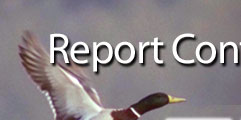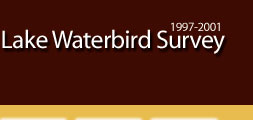 |
 |
 |
||||||||||||
 |
 |
 |
 |
 |
 |
 |
 |
|||||||
|
Preface • Introduction • Study Objectives • Community Participation • Regional, Physical and Ecological Setting Methods • Survey Protocol • Surveyors • Data Compilation • Data Analysis Results • Migration Chronology • Breeding Species • GSL Species Accounts • Species Distribution Discussion • Recommendations • Acknowledgements • Definitions/Abbreviations • Literature Cited Report & Appendices: 1 • 2 • 3 • 4 • 5 • 6 • 7 • 8 21-Year Waterbird Survey Synopsis & Appendices: 1B • 2B • 4B • 5B • 6B • 8B
|
RecommendationsThe data reported in this document are valuable to many entities around GSL and other organizations nationwide, and have been already shared with such groups while the study was ongoing. But because of the importance of this data set to so many, we recommend that it be updated on a regular basis. Population trends are most accurate when many years of data are available. As the GSL is a dynamic system, long-term data collection is even more important, to blend lake flooding and receding cycles into larger scale population trends (Table 18). Now that a baseline inventory of waterbird species around GSL has been completed, it is recommended that future efforts reduce the scale of study and focus on areas of high waterbird use as outlined in the document, “A Plan for Monitoring Shorebirds During the Non-breeding Season in Shorebird Monitoring Region Utah-BCR 9 (Great Basin)” (Manning et al 2002). Intensive survey work at the species level would also be valuable for those species that may not have been well detected through the Waterbird Survey protocol. For example, snowy plovers are small and cryptic, and are not located near the shoreline all of the time. Because Waterbird surveyors stayed 100 yards from the shoreline they may have missed plovers distributed on an expansive mudflat. A more concentrated area search at all appropriate habitat types would yield a more accurate number of snowy plovers at GSL. The same applies for other species. If a similar inventory using volunteer help is planned, we make the following recommendations. To minimize the variation in skill levels between surveyors, provide ample training for volunteers. This is best achieved in small groups, ideally at the survey team level, and at the particular site where volunteers will be doing their surveys. Keep the protocol as simple as possible. The point sample section of the data form used in this study was too complicated, and data that were not recorded properly could not be used. Survey routes should be limited to that which can be covered in 2 hours. The Waterbird Survey had many dedicated volunteers who gave much of their time over five years to contribute to this effort. It is easier to have consistent volunteers when their travel and survey time is kept to a manageable amount. Develop a schedule for waterbird surveys through time. This process should consider the monitoring protocols set for the through the North American Waterfowl Management Plan, National Shorebird Plan, Continental Waterbird Plan, and consider any actions recommended by Partners In Flight. The coordination of this effort should be an element of the Utah All Bird Committee and the Utah All Bird Plan. The Western Shorebird Survey is already in place, and Utah is organized and cooperating in the 2002 season. This commitment should be considered in developing survey schedules. (Complete by February 2003.) The GSL shorebird planning effort should be revisited using the GSL Waterbird Survey five-year data set as a conservation and implementation tool. This plan should be completed with the involvement of the primary land managers associated with the GSL shoreline and water bodies as proposed in the draft plan. (Complete by April 2004.) Community based data collection and data use were sub-objectives of the Waterbird Survey, and given this element, the database should be provided to cooperators for their use in conservation actions. It is recommended that electronic copies of the database be provided to the sponsoring institutions of Waterbird Survey team members. In addition, this report should be made available in hard copy to each Waterbird Survey team member, each sponsoring institution, and the organizations listed in the Acknowledgements. This report should be for sale in hard copy format in the Utah state of Utah Department of Natural Resources bookstore. We also recommend that this report be produced in an interactive format on CD-ROM and made available through the bookstore and at the Northern and Central UDWR regional offices. This format should also be put on the UDWR website through the Great Salt Lake Ecosystem Project link. The Paradox database should be appropriately archived in three or more locations to help insure its preservation through time. Copies should be housed in the Aquatic Section, GSLEP, the Wildlife Section, Habitat section, non-game bird coordinator’s office, and the waterfowl management coordinator’s office.
Table 18. Recommendations for further waterbird study at GSL and volunteer participation.
Go to Previous Section (Discussion) • Go to Next Section (Acknowledgements)... |